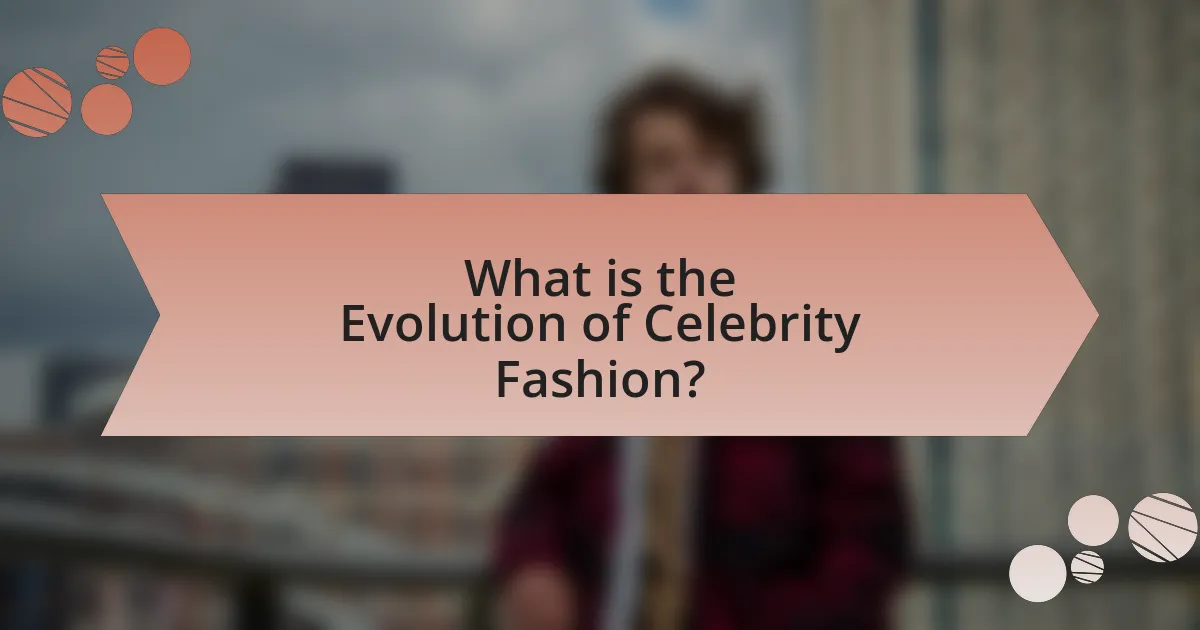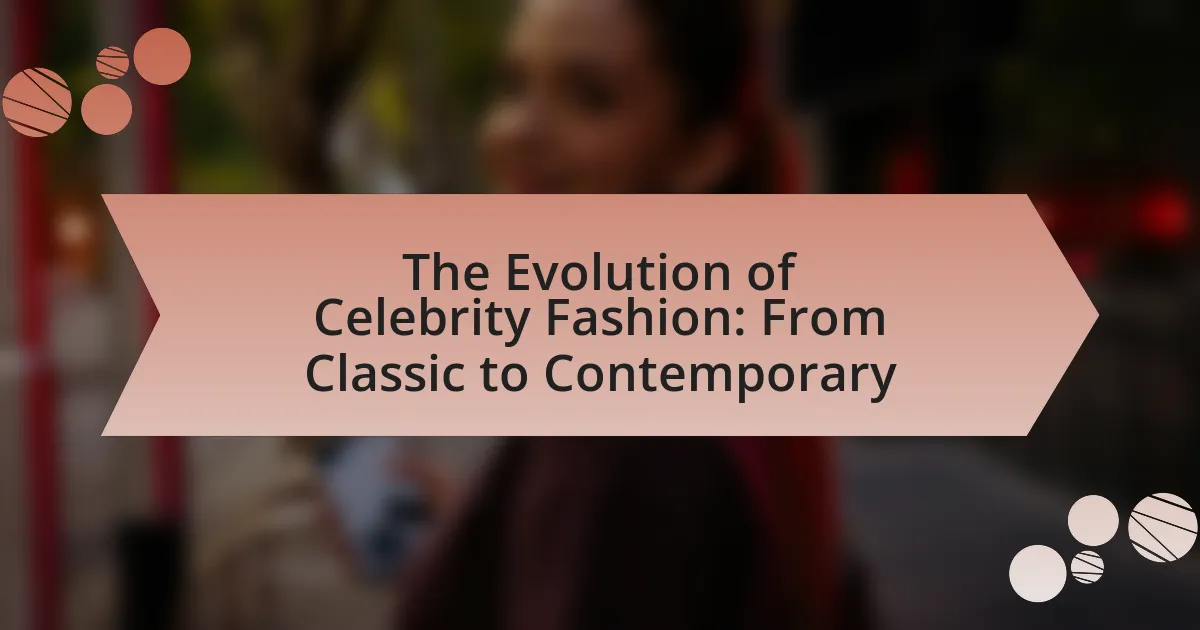The article examines the evolution of celebrity fashion, tracing its development from the early 20th century to contemporary styles. It highlights how societal norms, cultural influences, and technological advancements have shaped fashion trends, with key figures like Audrey Hepburn, Madonna, and Rihanna playing pivotal roles. The discussion includes the impact of media, significant historical events, and the rise of social media on fashion choices, as well as the importance of diversity and sustainability in modern celebrity fashion. Additionally, it analyzes the social implications of celebrity fashion trends on consumer behavior and body image, providing insights into how individuals can responsibly incorporate these trends into their own style.

What is the Evolution of Celebrity Fashion?
The evolution of celebrity fashion reflects changing societal norms, cultural influences, and technological advancements. In the early 20th century, celebrities like silent film stars set trends with glamorous, often extravagant styles that emphasized luxury and elegance. The 1950s and 1960s saw icons like Audrey Hepburn and Marilyn Monroe popularizing chic, tailored looks that combined femininity with sophistication, influenced by the rise of television and mass media.
By the 1980s and 1990s, celebrity fashion became more diverse and accessible, with stars like Madonna and Prince pushing boundaries through bold, eclectic styles that embraced individuality. The advent of the internet and social media in the 2000s transformed celebrity fashion further, allowing for real-time sharing of styles and trends, exemplified by influencers and reality TV stars who democratized fashion.
Today, celebrity fashion is characterized by a blend of high fashion and streetwear, with figures like Rihanna and Kanye West leading the charge in merging luxury with everyday wear. This evolution illustrates how celebrity fashion has continuously adapted to reflect broader cultural shifts, making it a dynamic and influential aspect of contemporary society.
How has celebrity fashion changed over the decades?
Celebrity fashion has evolved significantly over the decades, reflecting broader cultural shifts and societal values. In the 1950s, celebrities like Audrey Hepburn and Marilyn Monroe popularized classic, elegant styles characterized by tailored silhouettes and feminine aesthetics. The 1960s introduced a more rebellious spirit, with icons like Twiggy and The Beatles embracing bold patterns, mini skirts, and unisex styles, mirroring the counterculture movement.
By the 1970s, celebrity fashion became synonymous with individualism and self-expression, as seen in the rise of disco and bohemian styles, exemplified by figures like David Bowie and Cher. The 1980s brought about an era of excess, with celebrities such as Madonna and Prince showcasing flamboyant outfits, power suits, and vibrant colors, reflecting the decade’s emphasis on boldness and consumerism.
In the 1990s, minimalism emerged, influenced by grunge and hip-hop culture, with stars like Kate Moss and Will Smith favoring simpler, more casual attire. The 2000s saw the rise of reality TV and social media, leading to a more accessible and diverse fashion landscape, where celebrities like Paris Hilton and Kim Kardashian popularized trends that emphasized glamour and luxury.
Today, celebrity fashion is characterized by a blend of high fashion and streetwear, with influencers like Rihanna and Billie Eilish pushing boundaries and promoting inclusivity and sustainability. This evolution illustrates how celebrity fashion has continuously adapted to reflect changing societal norms and technological advancements.
What key historical events influenced celebrity fashion trends?
Key historical events that influenced celebrity fashion trends include the rise of Hollywood in the 1920s, which popularized glamorous styles through film stars like Clara Bow and Greta Garbo. The 1960s counterculture movement, marked by figures such as Twiggy and The Beatles, introduced bold, experimental fashion that challenged traditional norms. Additionally, the punk rock movement of the 1970s, exemplified by artists like David Bowie and the Sex Pistols, brought edgy, rebellious styles into the mainstream. The emergence of social media in the 2000s further transformed celebrity fashion, allowing influencers like Kim Kardashian to shape trends rapidly and directly engage with audiences. Each of these events not only reflected societal changes but also actively shaped public perceptions of fashion, making them pivotal in the evolution of celebrity style.
How did the rise of media impact celebrity fashion evolution?
The rise of media significantly transformed celebrity fashion evolution by amplifying visibility and accessibility to fashion trends. With the advent of television, magazines, and later social media platforms, celebrities became influential fashion icons, shaping public perception and consumer behavior. For instance, the 1990s saw the emergence of fashion magazines like Vogue and the impact of televised award shows, which showcased celebrity outfits, leading to increased public interest in designer brands. Additionally, social media platforms like Instagram have allowed celebrities to share their fashion choices directly with millions, creating instant trends and driving fast fashion industries. This direct engagement has made celebrity fashion more dynamic and responsive to cultural shifts, as seen in the rise of streetwear and sustainable fashion movements influenced by celebrity endorsements.
What are the defining characteristics of classic celebrity fashion?
Classic celebrity fashion is characterized by timeless elegance, tailored silhouettes, and luxurious fabrics. This style often features iconic pieces such as little black dresses, tailored suits, and vintage accessories that have stood the test of time. Historical examples include Audrey Hepburn’s classic Givenchy dress in “Breakfast at Tiffany’s” and Marilyn Monroe’s glamorous gowns, which exemplify the sophisticated and polished aesthetic of the era. These elements reflect a commitment to craftsmanship and a focus on creating a lasting impression, making classic celebrity fashion a benchmark for style throughout the decades.
Which iconic figures shaped classic celebrity fashion styles?
Marilyn Monroe, Audrey Hepburn, and James Dean are iconic figures who shaped classic celebrity fashion styles. Marilyn Monroe popularized the glamorous, feminine aesthetic with her form-fitting dresses and bold red lipstick, particularly seen in films like “Gentlemen Prefer Blondes.” Audrey Hepburn introduced a chic, elegant style characterized by timeless pieces such as the little black dress, notably in “Breakfast at Tiffany’s.” James Dean embodied a rebellious, casual look with his denim jeans and leather jackets, influencing youth culture in the 1950s. These figures not only defined their eras but also left lasting impacts on fashion trends that continue to resonate today.
How did classic fashion reflect societal values and norms?
Classic fashion reflected societal values and norms by embodying the ideals of the time, such as class distinction, gender roles, and cultural identity. For instance, during the Victorian era, fashion emphasized modesty and propriety, mirroring the era’s strict social codes and gender expectations. The use of corsets and layered garments illustrated the societal belief in femininity tied to restraint and decorum. Additionally, the opulence of clothing among the upper classes, characterized by luxurious fabrics and intricate designs, showcased wealth and status, reinforcing class hierarchies. Historical evidence, such as fashion plates and portraits from the period, further supports this connection, demonstrating how clothing choices were a direct reflection of the prevailing social values and norms.
What are the hallmarks of contemporary celebrity fashion?
Contemporary celebrity fashion is characterized by bold self-expression, inclusivity, and sustainability. Celebrities today often use fashion as a platform to showcase their individuality, embracing unique styles that reflect personal narratives rather than conforming to traditional norms. This shift is evident in the rise of diverse body representations and gender-fluid designs, promoting a broader acceptance of various identities within the fashion industry. Additionally, sustainability has become a significant focus, with many celebrities advocating for eco-friendly practices and supporting brands that prioritize ethical production methods. This evolution in celebrity fashion aligns with societal changes, emphasizing authenticity and responsibility in style choices.
How do modern celebrities influence current fashion trends?
Modern celebrities significantly influence current fashion trends through their visibility and social media presence, which allows them to set and popularize styles rapidly. For instance, platforms like Instagram and TikTok enable celebrities to showcase their outfits to millions, leading to immediate consumer interest and imitation. A study by the Journal of Fashion Marketing and Management found that 70% of consumers are influenced by celebrity endorsements when making fashion purchases, highlighting the direct impact of celebrity culture on consumer behavior.
What role does social media play in contemporary celebrity fashion?
Social media significantly influences contemporary celebrity fashion by providing a platform for instant visibility and engagement. Celebrities utilize platforms like Instagram and TikTok to showcase their outfits, often leading to immediate trends and viral fashion moments. For instance, a study by the Fashion Institute of Technology found that 70% of consumers are influenced by social media when making fashion purchases, highlighting the direct impact of celebrity endorsements on consumer behavior. This dynamic allows celebrities to shape fashion trends in real-time, creating a more interactive relationship between them and their audience.

What are the Major Influences on Celebrity Fashion?
Major influences on celebrity fashion include cultural trends, social media, designer collaborations, and public appearances. Cultural trends shape the styles that celebrities adopt, reflecting societal values and aesthetics. Social media platforms, particularly Instagram and TikTok, amplify fashion choices, allowing celebrities to showcase their outfits to a global audience and influence public perception. Designer collaborations, such as those between celebrities and fashion houses, create unique collections that often set new trends. Public appearances at events like award shows and premieres further dictate fashion choices, as celebrities aim to make impactful statements through their attire. These factors collectively drive the evolution of celebrity fashion, making it a dynamic and responsive aspect of contemporary culture.
How do designers and fashion houses impact celebrity fashion?
Designers and fashion houses significantly influence celebrity fashion by creating exclusive collections that celebrities often wear to public events, thereby setting trends. For instance, high-profile collaborations, such as Rihanna with Puma or Beyoncé with Adidas, showcase how designers leverage celebrity status to enhance brand visibility and desirability. Additionally, red carpet appearances often feature custom designs from renowned fashion houses, which not only elevate the celebrity’s image but also drive consumer interest in those brands. This symbiotic relationship is evident in the way fashion weeks and award shows highlight designer pieces, leading to increased sales and shaping public perceptions of style.
What collaborations between celebrities and designers have been significant?
Significant collaborations between celebrities and designers include the partnership between Rihanna and Puma, which resulted in the successful Fenty x Puma line, blending high fashion with streetwear aesthetics. Another notable collaboration is Beyoncé’s Ivy Park line with Adidas, which emphasizes inclusivity and empowerment in athletic wear. Additionally, the collaboration between Kanye West and Adidas for the Yeezy brand has transformed sneaker culture and generated billions in revenue. These partnerships have not only influenced fashion trends but also reshaped the relationship between celebrity influence and designer branding, demonstrating the power of celebrity endorsements in the fashion industry.
How do fashion weeks and events shape celebrity fashion choices?
Fashion weeks and events significantly influence celebrity fashion choices by showcasing the latest trends and designers, which celebrities often adopt to maintain their public image. During these events, high-profile designers present their collections, setting the tone for upcoming seasons. Celebrities, who are frequently invited to attend or walk the runway, use these platforms to align themselves with specific styles and brands, thereby shaping their fashion identity. For instance, the Spring/Summer 2023 Fashion Week saw numerous celebrities donning pieces from emerging designers, which led to increased visibility and sales for those brands. This symbiotic relationship between fashion events and celebrity endorsements drives trends and consumer behavior in the fashion industry.
What cultural factors contribute to the evolution of celebrity fashion?
Cultural factors such as social media influence, globalization, and shifting societal values significantly contribute to the evolution of celebrity fashion. Social media platforms like Instagram and TikTok allow celebrities to showcase their fashion choices instantly, creating trends that can spread rapidly among fans and followers. Globalization facilitates the exchange of diverse fashion styles across cultures, enabling celebrities to draw inspiration from various traditions and aesthetics. Additionally, changing societal values, including movements for body positivity and sustainability, influence celebrities to adopt and promote fashion that reflects these ideals, thereby shaping public perception and trends in the fashion industry.
How do music and film industries influence fashion trends?
The music and film industries significantly influence fashion trends by shaping public perception and consumer behavior through celebrity endorsements and visual storytelling. Celebrities often serve as trendsetters, with their clothing choices showcased in music videos, films, and public appearances, leading to widespread imitation among fans. For instance, the popularity of grunge fashion in the 1990s can be attributed to musicians like Kurt Cobain, whose style resonated with youth culture and was widely adopted. Similarly, films like “Clueless” popularized specific styles, such as the iconic plaid skirts, which became a fashion staple. This influence is further supported by the fact that fashion brands frequently collaborate with artists and filmmakers to create collections that reflect the aesthetics of popular media, thereby driving trends in the marketplace.
What role does diversity play in shaping modern celebrity fashion?
Diversity plays a crucial role in shaping modern celebrity fashion by influencing trends, representation, and consumer preferences. Celebrities from various backgrounds bring unique cultural perspectives and styles, which enrich the fashion landscape and promote inclusivity. For instance, the rise of diverse figures like Rihanna and Lupita Nyong’o has led to increased visibility for underrepresented styles and designers, driving brands to embrace a broader range of aesthetics. This shift is supported by data showing that brands with diverse representation see higher engagement and sales, reflecting consumer demand for authenticity and inclusivity in fashion.

How Can We Analyze the Impact of Celebrity Fashion?
To analyze the impact of celebrity fashion, one can examine social media engagement metrics, sales data, and cultural trends. Social media platforms like Instagram and TikTok provide quantifiable data on how celebrity outfits influence public perception and consumer behavior, with studies showing that 70% of consumers are more likely to purchase a product endorsed by a celebrity. Additionally, analyzing sales spikes following celebrity appearances at events, such as the Met Gala, can illustrate direct correlations between celebrity fashion choices and retail performance. Research by the Fashion Institute of Technology indicates that celebrity endorsements can increase brand visibility and desirability, further solidifying the significant role celebrities play in shaping fashion trends.
What are the social implications of celebrity fashion trends?
Celebrity fashion trends significantly influence societal norms and consumer behavior. These trends often dictate what is considered fashionable, leading to widespread adoption among the public. For instance, a study by the Journal of Fashion Marketing and Management found that celebrity endorsements can increase consumer purchasing intentions by up to 50%. This influence can perpetuate specific beauty standards and lifestyle aspirations, impacting self-esteem and body image among individuals, particularly youth. Additionally, celebrity fashion can drive discussions around cultural appropriation and sustainability, as seen in the backlash against celebrities who adopt styles from marginalized cultures without acknowledgment. Thus, the social implications of celebrity fashion trends encompass shifts in consumer behavior, the reinforcement of societal standards, and the emergence of critical conversations around cultural sensitivity and environmental responsibility.
How does celebrity fashion affect consumer behavior and purchasing decisions?
Celebrity fashion significantly influences consumer behavior and purchasing decisions by creating aspirational trends that consumers seek to emulate. When celebrities showcase specific styles or brands, their large followings often perceive these choices as desirable, leading to increased demand for similar products. For instance, a study published in the Journal of Fashion Marketing and Management found that 60% of consumers reported being influenced by celebrity endorsements when making fashion purchases. This phenomenon is further supported by the rise of social media, where platforms like Instagram amplify celebrity fashion visibility, driving immediate consumer interest and sales spikes for featured items.
What are the potential negative effects of celebrity fashion on body image?
Celebrity fashion can negatively impact body image by promoting unrealistic beauty standards. When celebrities showcase specific body types and styles, it can lead to comparisons among the general public, fostering feelings of inadequacy and low self-esteem. Research indicates that exposure to idealized images in media, including celebrity fashion, correlates with body dissatisfaction and disordered eating behaviors, particularly among young women. A study published in the journal “Body Image” found that individuals who frequently consume celebrity culture are more likely to experience negative body image and engage in unhealthy weight control practices.
What lessons can we learn from the evolution of celebrity fashion?
The evolution of celebrity fashion teaches us that trends are cyclical and heavily influenced by cultural shifts. For instance, the 1920s flapper style reflected women’s liberation, while the 1980s power suits symbolized female empowerment in the workplace. Additionally, the rise of social media has democratized fashion, allowing celebrities to set trends that can spread rapidly, as seen with influencers on platforms like Instagram. This evolution highlights the importance of adaptability in fashion, as styles must resonate with contemporary societal values and technological advancements.
How can individuals incorporate elements of celebrity fashion into their own style?
Individuals can incorporate elements of celebrity fashion into their own style by selecting signature pieces or trends that resonate with their personal aesthetic. For example, if a celebrity is known for a specific type of outerwear, such as a tailored blazer or a unique bomber jacket, individuals can seek similar styles that fit their body type and preferences.
Additionally, they can pay attention to color palettes and patterns favored by celebrities, adapting these choices to their wardrobe. Research indicates that 70% of consumers are influenced by celebrity endorsements in fashion, highlighting the impact of celebrity styles on personal choices. By mixing and matching these elements with their existing clothing, individuals can create a unique look that reflects both their personality and current fashion trends.
What are some best practices for following celebrity fashion trends responsibly?
To follow celebrity fashion trends responsibly, individuals should prioritize sustainability by choosing eco-friendly brands and second-hand clothing. This approach reduces environmental impact, as the fashion industry is responsible for significant pollution and waste; for instance, it contributes to 10% of global carbon emissions. Additionally, consumers should focus on personal style rather than blindly imitating celebrities, which encourages individuality and reduces the pressure to constantly purchase new items. Engaging in mindful shopping, such as researching the ethical practices of brands and investing in quality pieces that last, further supports responsible fashion consumption.
